Over the years goldfish (lat. Carassius auratus) has been the most popular, renown and favorite tank fish among aquarists. This is the fish that set the stage for aquarium husbandry appearance. In this article you will find detailed history of how the first goldfish was bred as well as how to keep, feed, care and breed the fish. All breeds are also described, we added photos of them and a short list of their distinctive features.
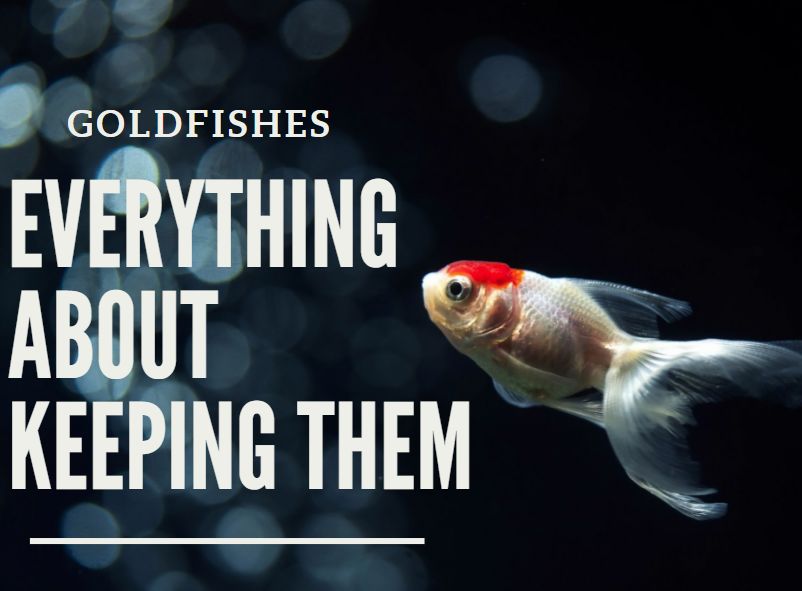
Contents
Goldfish breeds
First of all, all breeds can be divided into two large groups: those with long and short bodies. Fish with elongated body (comet, shubunkin, wakin and, of course, common goldfish) due to their body shape are the closest to their historical and genetic ancestor – golden carp. As a rule, only their fins are modified, sometimes the modification is rather significant.
As for the fish with short bodies, this is their body shape that has been essentially transformed if compared to the original one.
All these together with modified fins, eyes, outgrowths on a head stipulated higher demands of these species and the fact that they are more prone to various infections.
Common goldfish

Its size is mainly up to 30 cm long, but if kept in a pond the fish may grow up to 45 cm and weigh up to 1,5 kg. The fish size depends on the tank capacity and the pond size as well as on the amount of food it eats and the water temperature. The body of this fish is elongated and resembles the one of its ancestor – a common carp. The fish has bright red-orange coloring. Red and white varieties may also be encountered.
| Characteristic | Description |
|---|---|
| Scientific Name | Carassius auratus |
| Size | Varies based on breed, but typically 6 to 10 inches (15-25 cm) in length. Some can grow much larger in suitable environments. |
| Lifespan | 10 to 20 years on average, but can live longer with proper care. Some goldfish have been known to live up to 30 years or more. |
| Shape | Elongated body with a rounded belly and tapered tail fin. |
| Coloration | Wide variety of colors and patterns, including orange, red, white, black, yellow, and more. |
| Fins | Typically have two pectoral fins, two pelvic fins, two anal fins, one dorsal fin, and a caudal fin (tail fin). |
| Eyes | Bulging eyes on the sides of the head. |
| Habitat | Freshwater environments like ponds, aquariums, and slow-moving rivers. Goldfish are hardy and adaptable. |
| Temperament | Generally peaceful, social, and friendly with other non-aggressive fish. Can be interactive and recognize their owners. |
| Feeding | Omnivorous diet, consuming both plant matter and small aquatic creatures. Goldfish flakes, pellets, vegetables, and live/frozen foods are suitable. |
| Tank Requirements | Need a spacious aquarium with adequate filtration and regular water changes. A larger tank is better to accommodate their potential size. |
| Temperature Range | Prefer a water temperature between 65°F to 75°F (18°C to 24°C). |
| Water pH Range | Tolerant of a wide pH range, but usually thrive between 6.0 to 8.0. |
| Breeding | Goldfish are egg-layers, and breeding can occur in captivity under certain conditions. They do not provide parental care. |
| Common Health Issues | Prone to swim bladder disorders, parasites, bacterial infections, and fungal diseases. Overfeeding can lead to health problems. |
| Special Considerations | Avoid keeping goldfish in small bowls, as they require ample space to grow and thrive. Provide adequate filtration and maintain water quality. |
Comet goldfish
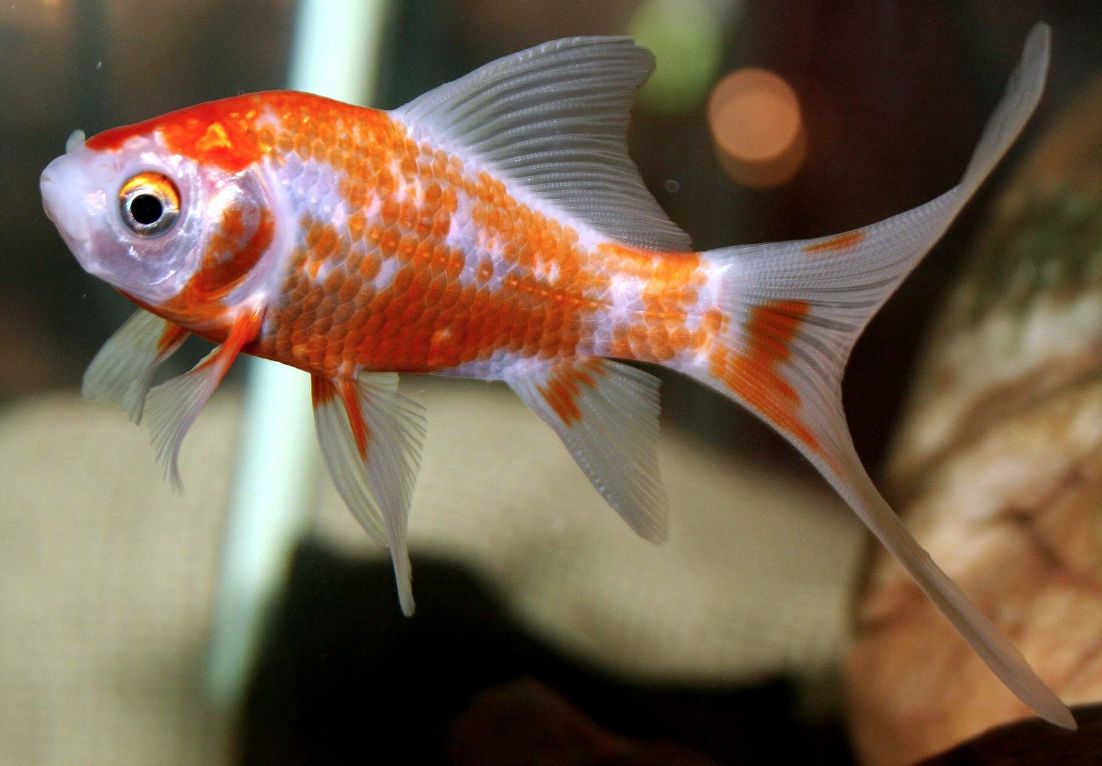
This is an active and fast breed of tank goldfish with elongated body. It can grow up to 18 cm long. Comet looks quite similar to a common gold carp. Though it has different coloring and longer fins.
Depending on the fish size they are divided into common comet – those with elongated tail fin and veiltail breed variations – with both elongated fins and tail. Thoroughbred breed representatives may have the lengths of their tail 3-4 times the size of their body length.
| Characteristic | Description |
|---|---|
| Common Name | Comet Goldfish |
| Scientific Name | Carassius auratus |
| Origin | United States |
| Size | Up to 12 inches (30 cm) in length |
| Lifespan | 10 to 15 years (can live longer with proper care) |
| Body Shape | Elongated and streamlined, resembling a comet |
| Fin Configuration | Single dorsal fin, paired pectoral, pelvic, and anal fins |
| Coloration | Various colors, including red, orange, yellow, white, and black |
| Tail Shape | Long, forked tail (comet-shaped) |
| Behavior | Active and fast-swimming; may leap out of the water |
| Ideal Water Temperature | 65°F to 75°F (18°C to 24°C) |
| Water pH Level | 6.0 to 8.0 |
| Water Hardness | 5 to 20 dGH (soft to moderately hard water) |
| Minimum Tank Size | 30 gallons for a single fish, larger for multiple fish |
| Diet | Omnivorous, eats flakes, pellets, and live/frozen foods |
| Tank Environment | Provide hiding spots, plants, and open swimming areas |
| Compatibility | Generally peaceful, but avoid mixing with fin-nipping fish |
| Tank Maintenance | Regular water changes and filtration are essential |
Shubunkin goldfish
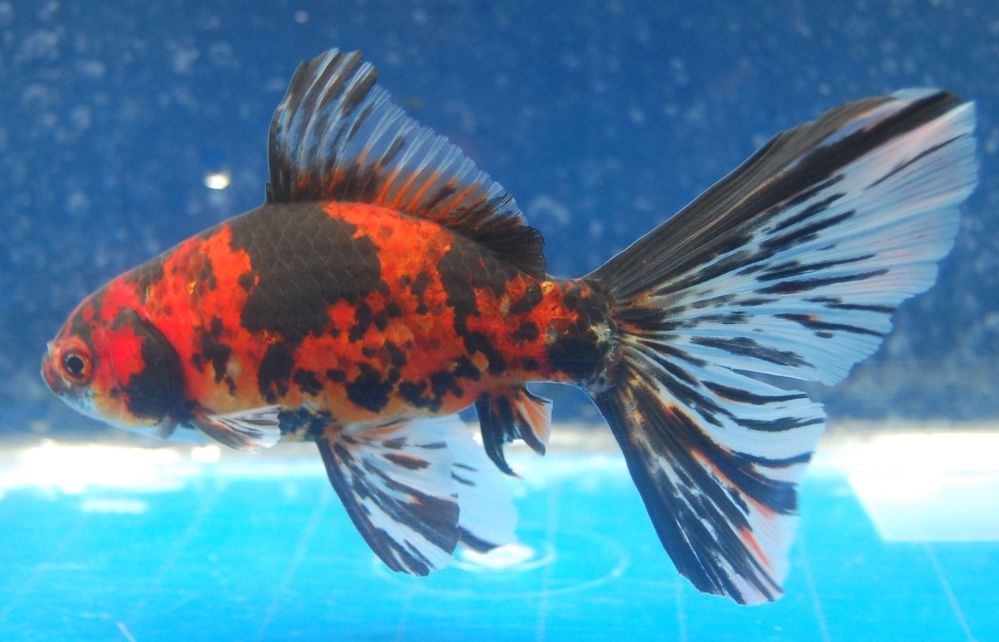
In Europe and the USA there three acknowledged shubunkin breed standards – American, Bristol and London subunkin. Technically, these are completely different fishes and all they have in common is just their indicative calico coloring.
This is their coloring that became the most famous distinctive feature of the fish and later other selective breeders started adding calico coloring to other variations including those with short bodies.
As for the fish temper, shubunkin is significantly calmer than comets, which makes the fish more suitable for keeping in a tank where any goldfish with elongated or even some with short bodies may be their tank mates.
| Characteristic | Description |
|---|---|
| Origin | Japan |
| Size | 6 to 10 inches (15 to 25 cm) |
| Lifespan | 10 to 15 years or longer with proper care |
| Body Shape | Elongated and streamlined, similar to a common goldfish |
| Body Color | Varied and vibrant colors with speckles and patches |
| Finnage | Long, flowing fins with a mix of colors |
| Tail Types | Double tail or single tail with broad, sweeping fins |
| Pattern Variations | Calico-like patterns, often described as mottled |
| Temperament | Generally peaceful and social, can be kept in groups |
| Coldwater Fish | Requires cool water temperatures between 65-75°F (18-24°C) |
| Tank Size | Minimum 20-gallon tank for a single fish |
| Water Conditions | Neutral pH (around 7.0), well-filtered and well-oxygenated water |
| Diet | Omnivorous – Pellets, flakes, veggies, and live/frozen foods |
| Tank Setup | Plenty of open swimming space and hiding spots |
| Water Hardiness | Tolerates a range of water conditions |
| Breeding | Egg-layers, breed in ponds with plants or spawning mops |
| Health Concerns | Prone to swim bladder issues and respiratory problems |
| Special Considerations | Avoid sharp decorations that may tear delicate fins |
Wakin goldfish
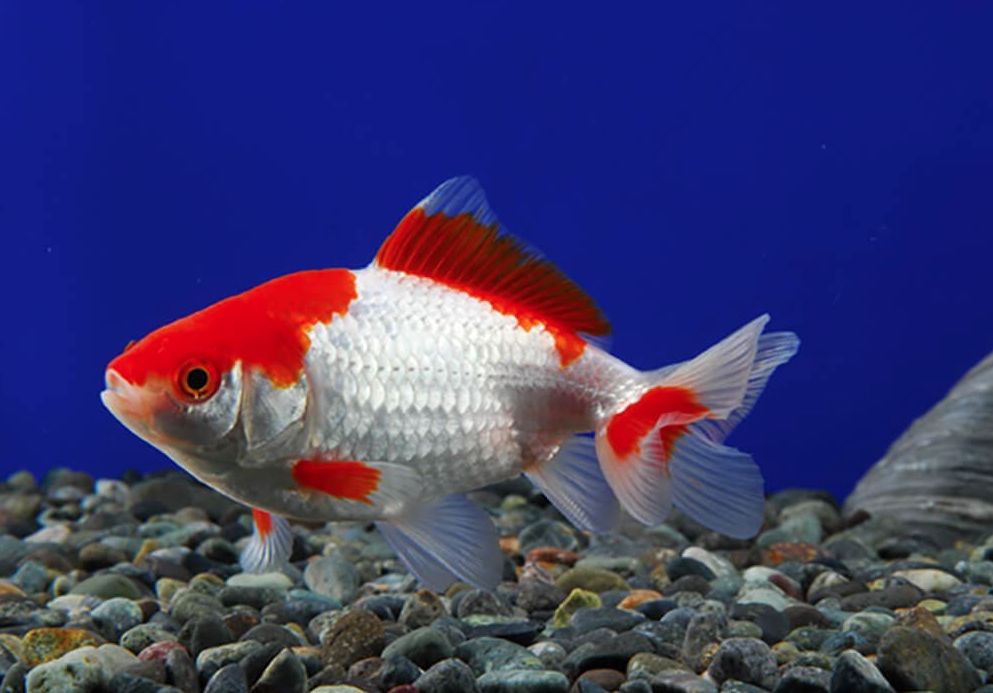
Wakin or Japanese goldfish differs from the common one in its tail shape – it is a claw-ended one. Wakin is considered to be a prototype of the majority of short bodied goldfish types with claw-ended tail fins. Due to its size (up to 30 cm) wakin is more suitable for keeping in ponds. This breed isn’t standardized in the USA and UK.
| Characteristic | Description |
|---|---|
| Origin | Japan |
| Size | Medium to large; typically 8 to 18 inches (20 to 45 cm) |
| Body Shape | Elongated and robust |
| Tail Shape | Double tail with broad lobes |
| Coloration | Various colors and patterns (red, white, orange, etc.) |
| Eye Placement | Protruding eyes |
| Fins | Long, flowing fins |
| Behavior | Active and hardy fish |
| Temperature Range | 65°F to 75°F (18°C to 24°C) |
| Water Conditions | Prefer freshwater with good filtration |
| Diet | Omnivorous; eat both plant matter and small insects |
| Lifespan | 10 to 20 years or more with proper care |
| Tank Size | Larger tanks are preferable due to their size |
| Tank Mates | Peaceful community fish; avoid fin nippers |
Fantail goldfish
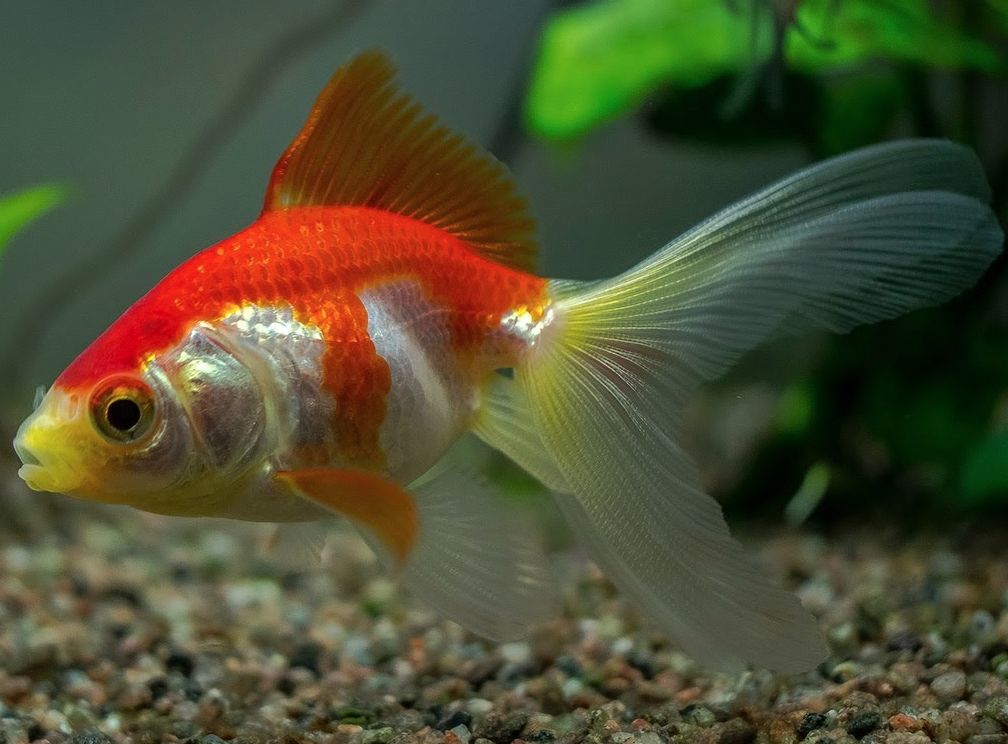
Fantail is quite a large fish with a bit elongated oviform body, but with claw-ended tail fin. It can have various coloring: red, red-orange, two- and three-color, calico and pink. Calico colored varieties may have metallic tint on some of their scales.
| Characteristic | Description |
|---|---|
| Body Shape | Short, rounded body with a double caudal fin |
| Tail Type | Double tail (butterfly-shaped) |
| Coloration | Various colors and patterns |
| Eyes | Bulging and positioned on the sides of the head |
| Size | Can grow up to 6-8 inches (15-20 cm) |
| Lifespan | 10-15 years or more |
| Temperament | Peaceful and social |
| Feeding | Omnivorous, eats fish flakes, pellets, and live/frozen foods |
| Tank Size | Requires a spacious tank due to its double tail and potential size |
| Water Conditions | Prefers clean, well-filtered water |
| Temperature Range | 65°F to 78°F (18°C to 26°C) |
| pH Range | 6.0 to 8.0 |
| Compatibility | Generally compatible with other goldfish varieties, avoid mixing with aggressive fish |
Ryukin goldfish
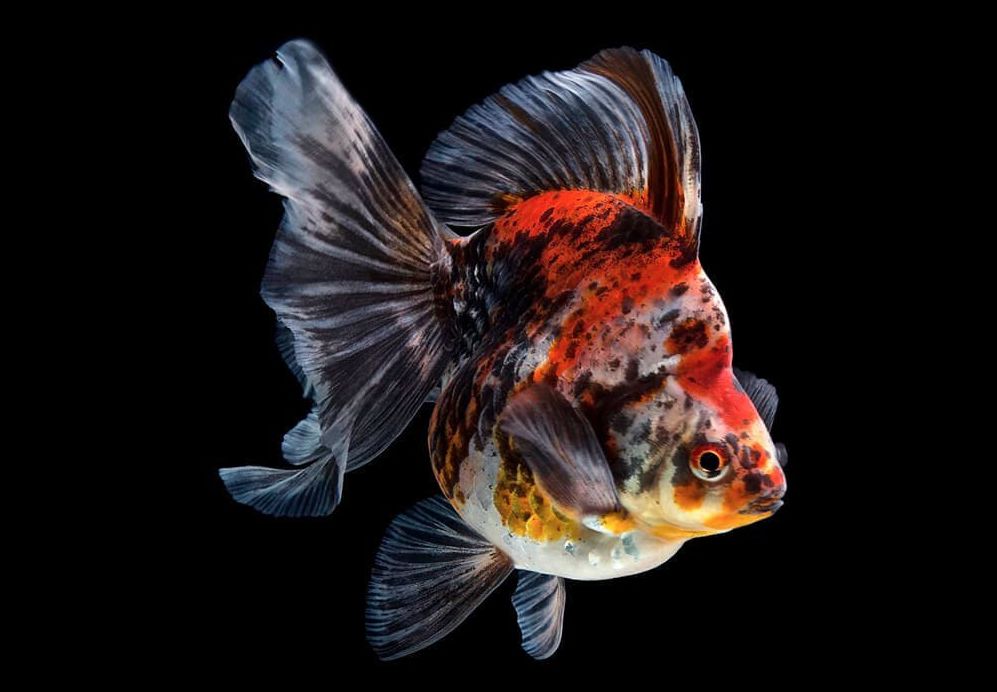
Ryukin is a fish type bred in Japan and it is considered to be a fantail prototype. Its body is oviform, very short and swollen. A distinctive feature of the breed is its ‘hood’ that begins from the fish head and goes down to the tail fin. The fish head is large with a bit enlarged eyes. The body coloring may be quite various – red, two- and three-color, pink and calico.
| Characteristic | Description |
|---|---|
| Origin | Japan |
| Body Shape | Compact and egg-shaped body with a humpbacked appearance |
| Size | Medium to large-sized fish, typically reaching 6 to 8 inches (15 to 20 cm) in length |
| Coloration | Wide variety of colors and patterns, including solid colors, calico, metallic, and variegated |
| Fins | Double caudal (tail) fin with a split and fan-like appearance, long flowing dorsal and anal fins |
| Eyes | Protruding and large eyes that are characteristic of fancy goldfish |
| Head Growth (Nuchal Hump) | Prominent nuchal hump on the back of the head, more pronounced in mature males |
| Swimming Behavior | Active and agile swimmers, but may have slower mobility due to their body shape |
| Temperament | Generally peaceful and can be kept with other non-aggressive goldfish |
| Care Difficulty | Moderate; requires clean water, appropriate filtration, and regular maintenance |
| Lifespan | 10 to 15 years, or even longer with proper care |
Veiltail goldfish
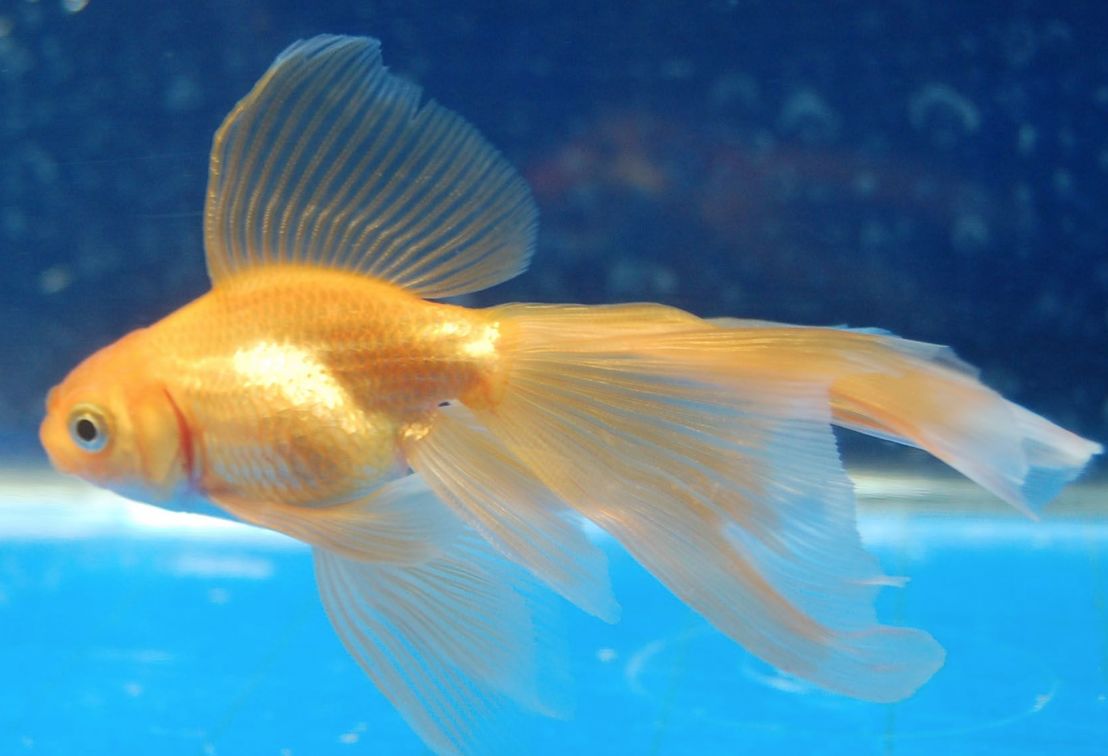
This is a very appealing goldfish, it is a calm and slow tank dweller with oviform or spherical body about 20 cm long. Ryukin is thought to be its direct prototype. Main distinctive feature of veiltail is its extremely long fins, especially the tail one.
| Characteristic | Description |
|---|---|
| Body Shape | Elongated body with a single caudal fin |
| Tail Type | Long, flowing and feathery veil-like tail |
| Tail Length | Typically longer than the body |
| Dorsal Fin | Long, flowing dorsal fin |
| Colors | Various colors, including orange, red, white, etc. |
| Size | Can grow up to 6-8 inches (15-20 centimeters) |
| Lifespan | Usually 10-15 years, but can live longer with care |
| Temperament | Generally peaceful and social |
| Care Difficulty | Moderate, requires a well-maintained aquarium |
| Water Parameters | Temperature: 65-72°F (18-22°C); pH: 6.0-8.0 |
| Tank Size | At least 20 gallons for a single Veiltail |
| Feeding | Omnivorous, diet includes pellets, flakes, and veggies |
| Tank Decoration | Avoid sharp objects to prevent tail damage |
| Common Health Issues | Swim bladder problems, fin rot, and constipation |
Telescopic eye goldfish
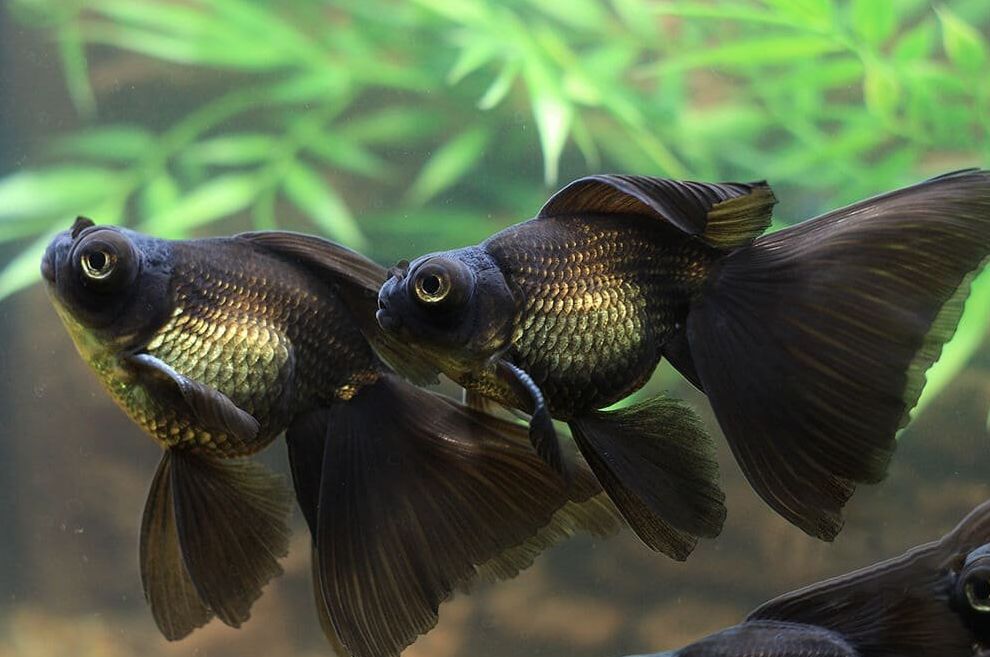
The feature of this fish is its large sized eyes. Their shape, size and axis direction vary greatly. Eyes of this fish may be up to 5 cm in diameter and be of spherical, cylindrical and conic shape. Quite often axis of each eye is perpendicular to the fish head surface and the axes are directed in different ways.
We should mention, that these protuberant eyes is a true sign of the breed that is always inherited by the offspring, even in case of accidental or intentional breeding of telescope eye with other breeds.
| Characteristic | Description |
|---|---|
| Scientific Name | Carassius auratus |
| Common Name | Telescope Eye Goldfish |
| Origin | China |
| Adult Size | Up to 6-8 inches (15-20 cm) |
| Lifespan | 10-15 years or more in proper care |
| Body Shape | Elongated oval with a slightly compressed body |
| Eyes | Prominent and protruding eyes |
| Eye Position | Eyes point upward and outward from the head |
| Eye Vision | Poor eyesight, nearsighted, poor depth perception |
| Finnage | Double caudal (tail) fin, paired pectoral fins |
| Colors | Various colors and patterns, including red, white, black, orange, calico, etc. |
| Scales | Metallic or nacreous scales |
| Behavior | Generally peaceful, social and friendly |
| Ideal Tank Size | 20 gallons or more for one goldfish, additional 10 gallons per additional fish |
| Water Conditions | pH: 6.0-8.0, temperature: 65-72°F (18-22°C), clean and well-filtered water |
| Diet | Omnivorous, will eat both plant matter and small aquatic organisms |
| Feeding | Small frequent feedings, avoid overfeeding |
| Tank Decorations | Soft, rounded objects to prevent eye injury, avoid sharp decorations |
| Tank Mates | Peaceful, non-nipping fish; avoid long-finned species |
| Common Health Issues | Swim bladder problems, eye injuries, and infections |
| Special Considerations | Fragile eyes prone to injury, avoid bright lights |
| Breeding | Egg-laying species, requires specific conditions for breeding success |
Oranda goldfish
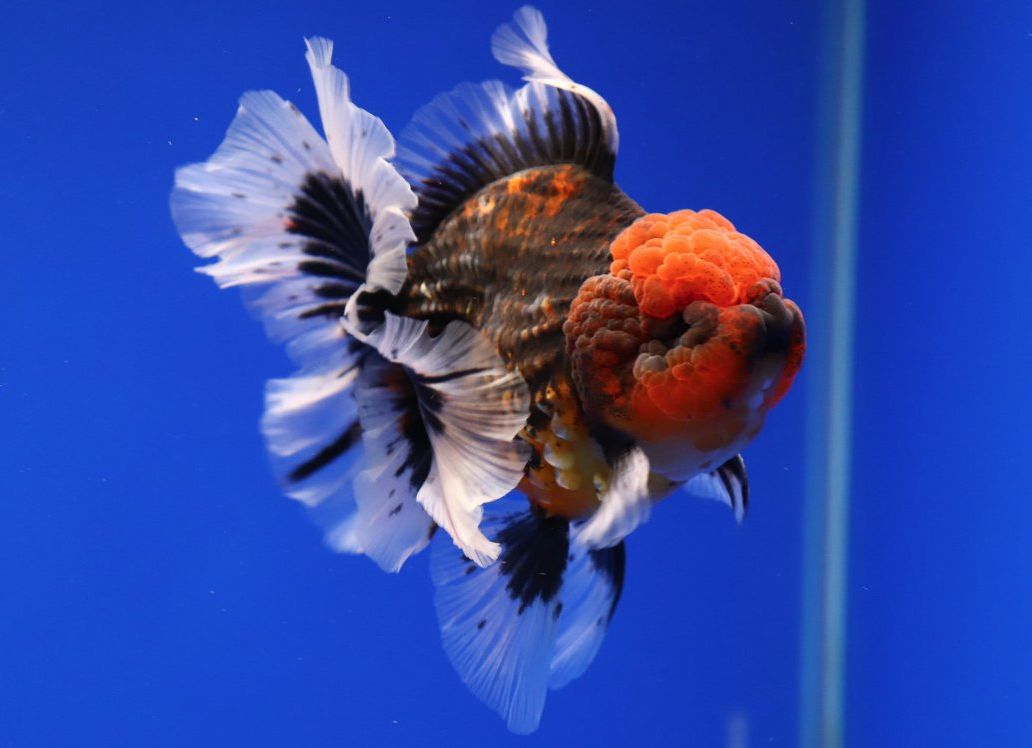
Characteristic of this fish is fleshy outgrowths it has on its head and upper side of gill covers. Quite often these are combined with nice long fins. The outgrowths may be of different shape and color, cover both just the upper side of the fish head and the whole head, sometimes they even cover the fish eyes completely.
Specialists tend even to divide some subvarieties of the breed according to the type of outgrowths they have. Thus, «pompom» (it has an outgrowth just on its nose), «lionchu» (the outgrowths uniformly cover all its head) – they were described as separate species.
| Characteristic | Description |
|---|---|
| Origin | China |
| Size | Medium to Large (6 to 12 inches or 15 to 30 centimeters) |
| Body Shape | Egg-shaped with a rounded, large belly |
| Wen (Head Growth) | Prominent, fleshy growth on the top of the head |
| Coloring | Wide variety of colors including red, orange, black, white, calico, etc. |
| Fins | Flowing and long, typically paired with a split caudal (tail) fin |
| Eyes | Protruding eyes that may appear telescope-like |
| Scales | Metallic and reflective, overlapping |
| Temperament | Generally peaceful and sociable |
| Swimming Behavior | Slower and less agile compared to other goldfish types |
| Lifespan | 10 to 15 years or more with proper care |
| Tank Size | Requires a spacious aquarium due to their size and need for swimming space |
| Water Conditions | Prefers clean and well-maintained water |
| Feeding | Omnivorous, will eat a variety of foods including pellets, flakes, and fresh vegetables |
| Tank Mates | Compatible with other peaceful goldfish varieties |
| Special Considerations | Careful maintenance of the wen to prevent infections |
Lionchu and Ranchu goldfishes
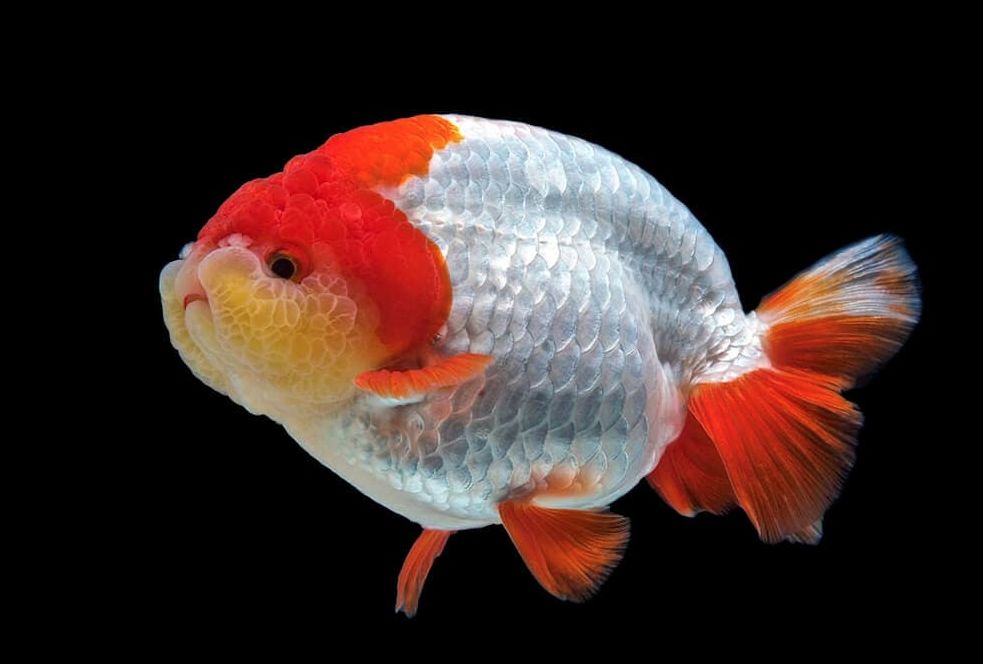
These two breeds are very similar to each other. Nevertheless, specialists from the UK and USA define them as separate ones indicating the following differences. Thus, outgrowths on Lionchu head (especially on its sides) are more pronounced than that of a Ranchu.
The latter has more curved back and upper side of its tail fin has about 45º deflection angle from the baseline. Lionchu back is more straight and upper side of its tail fin actually extends its back contour.
| Characteristic | Description |
|---|---|
| Origin | Japan |
| Size | Small to medium-sized (up to 8 inches / 20 cm) |
| Body Shape | Egg-shaped body with a pronounced hump (headgrowth) on the back of the head |
| Tail Shape | Double tail, short and rounded |
| Finnage | Short and stubby fins |
| Colors | Various colors and patterns, commonly red, white, black, and calico |
| Eyes | Large and protruding |
| Swimming Ability | Moderate swimmers due to their body shape |
| Care Difficulty | Moderate |
| Lifespan | 10 to 15 years or more |
| Tank Size | 20 gallons per fish minimum |
| Water Conditions | Temperature: 65°F to 75°F (18°C to 24°C) |
| pH: 6.5 to 7.5 | |
| Ammonia and nitrite should be kept at zero | |
| Diet | Omnivorous, a balanced diet of pellets, flakes, and occasional live/frozen foods |
| Tank Set-up | Provide ample space and hiding spots |
| Use fine sand or rounded gravel as substrate | |
| Regular water changes are crucial | |
| Compatibility | Peaceful, but avoid housing with aggressive tankmates |
| Common Health Issues | Swim bladder problems, fin rot, and fungal infections |
| Special Considerations | The hump on the head can grow with age and may require additional care |
Pearlscale goldfish
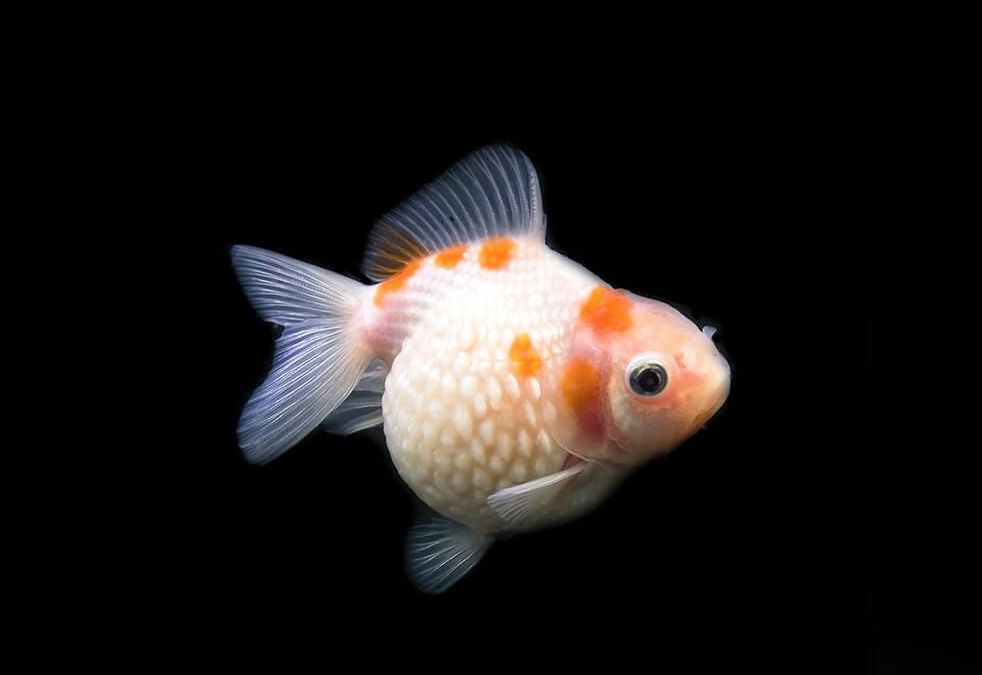
This goldfish breed is characterized by a swollen oviform body of an average size (up to 15 cm long) with short pectoral and lateral fins. The distinctive feature of the fish is its bulbaceous scales that due to their shape resemble a pearl cut into halves.
We should also mention that pearlscale is decidedly not the fish for beginners. It is very demanding in terms of tank conditions and care. Main requirement is clean water and absence of ammonia and nitrites in it. The fish is highly prone to various infectious diseases.
| Characteristic | Description |
|---|---|
| Body Shape | Round, egg-shaped body |
| Scale Appearance | Domes or raised bumps (like pearls) on the scales |
| Scale Coloration | Can vary widely, including metallic, red, white, etc. |
| Fins | Typically have short, stubby fins |
| Size | Medium-sized, reaching around 5-7 inches (12-18 cm) |
| Lifespan | 10 to 15 years or more with proper care |
| Temperament | Generally peaceful and social |
| Swimming Behavior | Slower, less agile swimmers compared to some breeds |
| Tank Size | Minimum 20-gallon tank for one Pearlscale |
| Water Conditions | Prefer stable, clean water with a pH of 6.5 to 8 |
| Water Temperature | 65°F to 75°F (18°C to 24°C) |
| Diet | Omnivorous, will eat both plant and animal matter |
| Feeding Habits | May need special care due to their body shape |
| Breeding Difficulty | Moderate, requires controlled breeding conditions |
| Common Health Issues | Prone to swim bladder problems due to body shape |
| Unique Feature | Distinctive domed scales giving a “pearly” appearance |
Celestial Eye goldfish
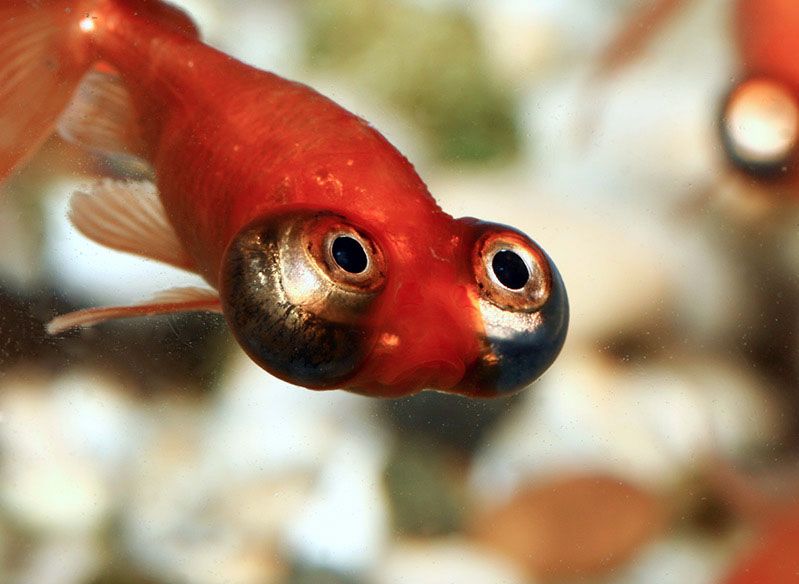
The Celestial Eye goldfish, also known as the stargazer goldfish, is a unique and visually striking variety of goldfish. It is characterized by its upward-pointing, telescope-like eyes, which give it a celestial or stargazing appearance. Characteristic of celestial eye is its eyes directed almost upward vertically. It has no dorsal while its anal and tail fins are claw-ended.
| Characteristic | Description |
|---|---|
| Common Name | Celestial Eye Goldfish |
| Scientific Name | Carassius auratus |
| Origin | China |
| Size | Small to medium-sized, typically 6-8 inches (15-20 cm) |
| Lifespan | 10-15 years |
| Body Shape | Egg-shaped with a protruding, upward-looking pair of eyes |
| Eye Placement | Eyes are directed upward, giving a “stargazing” appearance |
| Eye Characteristics | Large, protruding, and often telescope-like appearance |
| Color Varieties | Wide range of colors, including red, orange, white, black, etc. |
| Finnage | Double-tail or twin-tail, long flowing fins |
| Water Temperature | 65°F to 78°F (18°C to 26°C) |
| Water pH | 7.0 to 8.4 |
| Tank Size | Minimum 20 gallons for a single fish, larger for multiple |
| Tank Environment | Freshwater, well-filtered, with hiding spots and smooth substrate |
| Diet | Omnivorous, eats both commercial fish flakes and live/frozen foods |
| Temperament | Peaceful and social, can be kept with other peaceful fish |
| Special Considerations | Delicate eyes, avoid sharp or rough tank decorations |
Bubble Eye goldfish
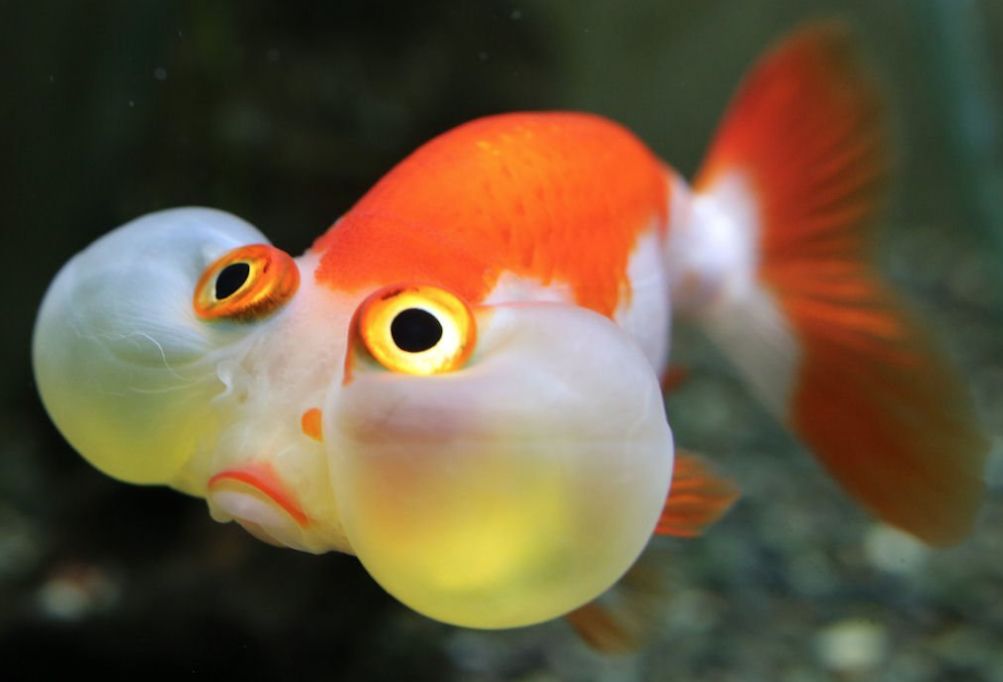
Due to its body shape and fins this fish resembles the previous breed, but its hypertrophied optic vesicles (apples of its eyes are directed frontwards, not upwards) is what makes it different.
The fish requires special care and caution when keeping it.
Large bubbles on both sides of the fish head look as if they are filled with water. It is very easy to damage them with any mechanical action. Bubble eye is a very delicate fish, prone to bacterial and fungous diseases, that’s why we can hardly recommend it to beginning aquarists.
| Characteristic | Description |
|---|---|
| Appearance | Rounded body with flowing, long fins |
| Eye Bubbles | Large, fluid-filled sacs under each eye |
| Color | Wide range of colors, including red, orange, black, etc. |
| Size | Typically 6 to 8 inches (15 to 20 cm) in length |
| Lifespan | 10 to 15 years with proper care |
| Temperament | Generally peaceful and gentle |
| Tank Size | Preferably 20 gallons per fish (or more) |
| Tank Environment | Smooth surfaces to prevent injuries from sharp objects |
| Water Conditions | Clean, well-filtered water with regular water changes |
| Temperature Range | 68°F to 74°F (20°C to 24°C) |
| Feeding | Omnivorous; diet includes pellets, flakes, and veggies |
| Special Considerations | Extremely delicate fins and eye sacs prone to damage |
| Avoid housing with aggressive or fin-nipping fish | |
| Requires careful handling and maintenance |
History of goldfish appearance
When the fish was first mentioned
The history of goldfish breeding goes back centuries. First ancestors of modern fish were found in Asia and a common carp (Carassius auratus auratus) was their forbear. More than thousand years ago in China and Korea they not only captured fish, but also bred and grew fishes on fish farms.
Over the years of selective breeding Chinese fish farmers obtained natural mutations with radical change of the fish body shape, fins, skin cover and eyes structure, coloring.
They also got ornamental fish species and color variations, that became the backbone of the most species variations that are known today.
First record of a goldfish with red scales comes from China, it was during Jin dynasty (265—420 A.D.). At that time these fish were noticed in a pond of Lushan mountain, Red River district close to present Shaanxi province.
The river flows along South China and North Vietnam. In Shan Hai Jing that is an Old Chinese essay written approximately on the cusp of A.D. there is also a record about a ‘red carp’.
However, we can’t be sure that these wild species were the ancestors of the species we know nowadays. It is assumed, that red coloring of the fish was obtained as a result of targeted selective breeding performed by the first aquarists during Tang dynasty (618—907 A.D).
Possibly Buddhism which was quite spread in that area, somehow aided the appearance of the fish with unusual body shapes: since for humanitarian reasons people didn’t kill ‘abnormal’ and ‘ugly’ fish species, but put them into specially designed fish farms or ponds and then into ornamental bottles and containers.
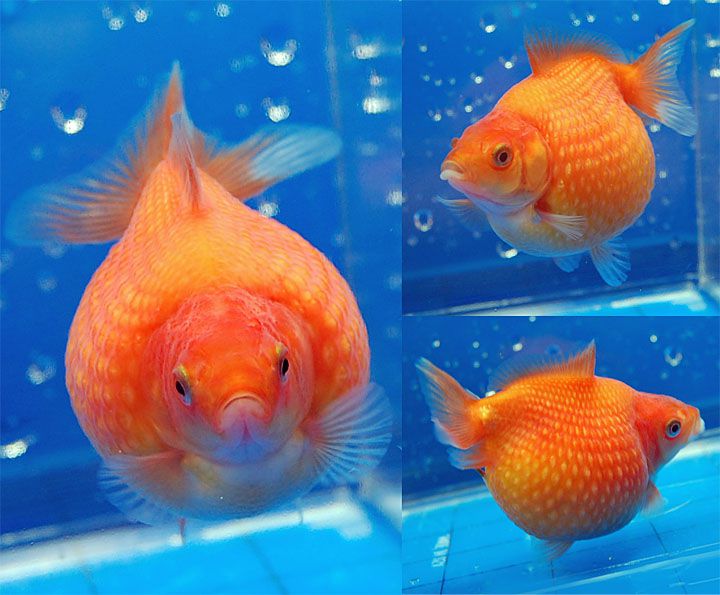
How the first breeds appeared
After 960s during Song dynasty the goldfish together with many other animals became popular pets kept in home pools. This period is considered to be the beginning of the domestication.
At first, the fish was a decoration of reach and wealthy houses and estates, the size of which allowed to have private pools and fountains. Popularity and demand for goldfish species has become the foundation of the fish breeding and selling business. In XIII new subspecies of goldfish appeared.
Starting from this period of time and till XVI the fish gradually changed the place of its dwelling from large pools and reach houses to where the ordinary Chinese lived.
At the beginning they were kept in small ponds as well as in wooden tubs that lately were modified into spherical vats made of clay and than there were ceramic and porcelain vases made for richer peerage customers.
In 1369 Chinese emperor Hongwu organized manufacturing of large porcelain containers to keep fish in captivity. Such containers were the first analogue of a home aquarium, they were called ‘a fish pond’ or ‘a dragon’s vase’ and this means that they were relatively large.
The wide necktube of the container allowed to observe the fish from outside – just like in a pond: this is why during artificial selection the aim was to create a fish that would look nice when looking at it from top. Luxurious elegant porcelain vases were made as ovals, spheres, barrels and short wide vases, they were decorated with paintings and plasterwork.
To make the container settled they made legs for it stylized as animal paws and fish fins or some special stands were made to put containers on them. A craftsman had to be very skilled and experienced to work with thin porcelain and ceramics and create these containers to keep fish in them.
Sometimes they used to put a small amount of sand and plants onto container bottom, though as a rule they were empty with just one or several fish in it.
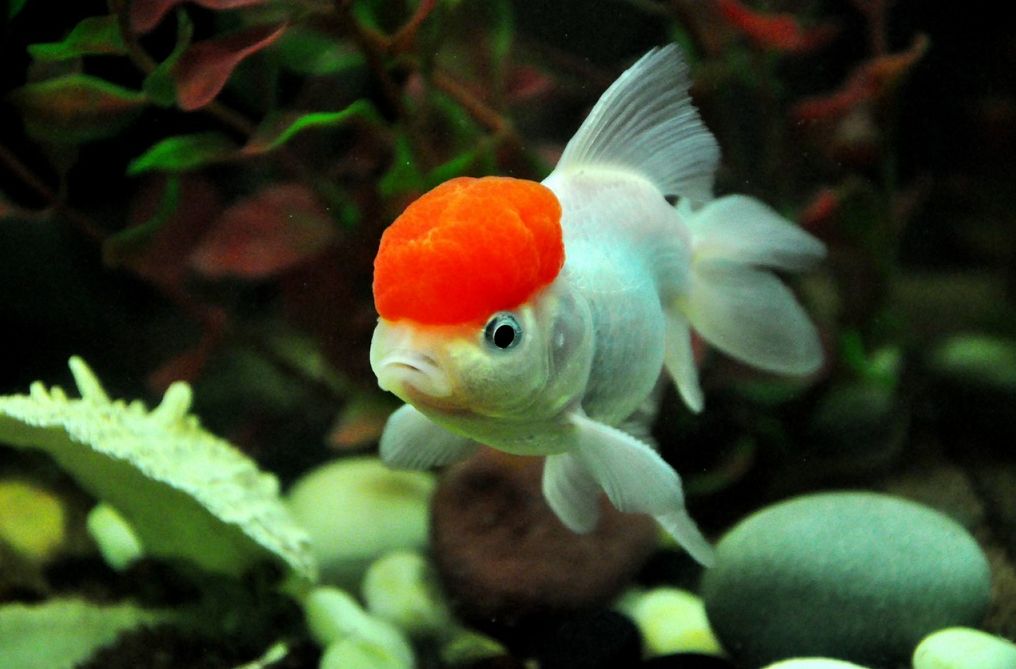
How the fish expanded over the world
The story of how the fish spread in Asia is not clear enough. It is possible, that first of all goldfish expanded over Indo-China and countries neighboring with China; then at the beginning of XVI century the fish got to Japan which had become a birthplace of many new species.
Japanese breeders that according their national art traditions striven to create exquisite and harmonious shapes have become acknowledged leaders in breeding. In XVII due to Dutch and Portuguese merchants arrived to Europe, where it costed a fortune at first, therefore only the richest people could afford getting the fish.
In XIX both centralized fish delivery from China gradually developed as well as local breeding, all these led to the prices decrease. Nevertheless, till now main variations of the goldfish are represented by the breeds brought from the Far East countries.
The first known records of the species export to Europe from China (Zhejiang province) date back to 1611, 1691 and 1728. There is no reliable information about which kind was in priority in European countries. According to one sources, the fish was brought from Macao, another sources state that these tank fish were delivered from Java and South Africa to Portugal.
We know that this happened in XVII since literature sources mention two dates: 1611 or/and 1691 but because of the absence of some reliable and accurate sources these dates are still in question. At the same period of time (1691) England was mentioned as well. In XVIII the species became widespread all over the Europe.
First ‘bills’ that provide evidence of selling the goldfish in the Northen Europe were documented in Holland in 1728. In the USA the fish first appeared in 1874-1878 and became the forebears of the collection in Washington State Fish Hatchery.
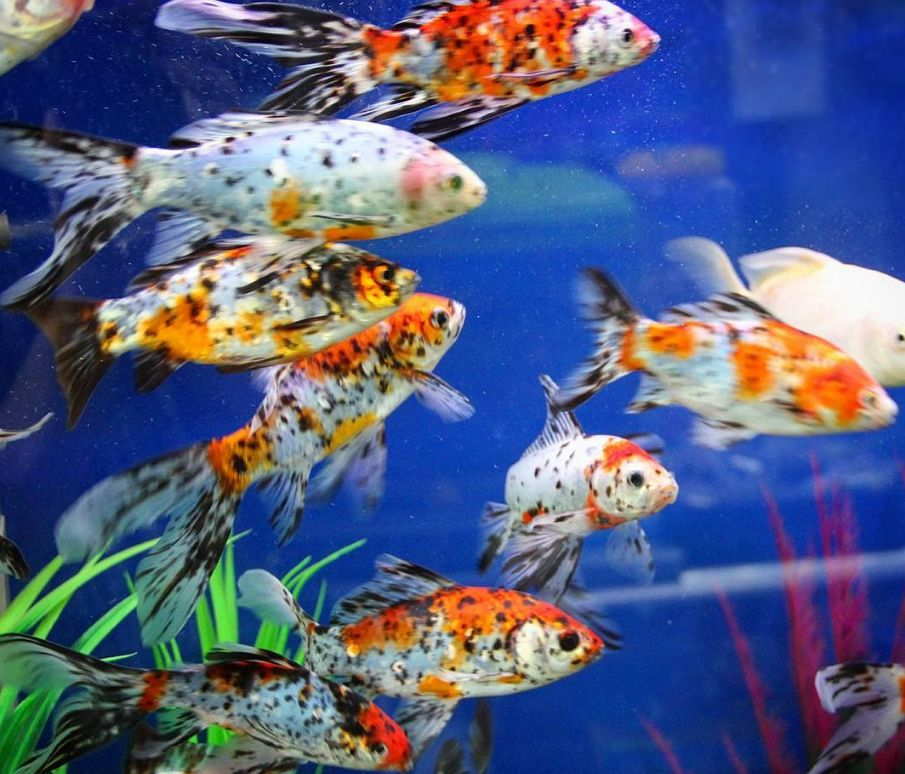
Care and keeping in a tank
In general, we can put it this way: keeping species in a tank won’t be a troublesome thing to do, if you fulfill the following conditions – provide the fish with a roomy tank, don’t put too many fish species in it, equip the tank with powerful filtration and aeration system as well as perform regular partial water renews.
Water temperature
Fishes prefer cool water, however, it was noticed that don’t always feel comfortable when the water temperature is about 18-20 °C (65-68 °F).
This is especially true about locally bred fish species that grew in tanks. Besides, fishes such as pearlscale, ranchu, lionchu are considered to be thermophilic ones.
You can maintain the water temperature about 22-25 °C. You should choose it according to how your pets feel, but keep in mind that if the temperature is too high it causes accelerated ageing of the fish.
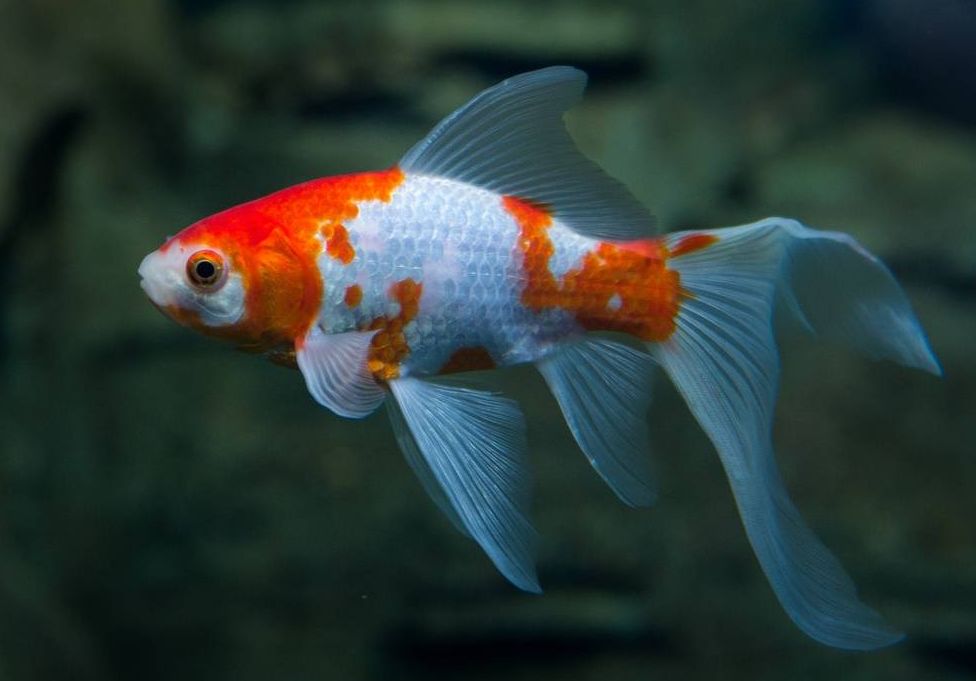
Volume of the tank
This is one of the ‘cornerstones’ of fish keeping – the tank volume and density of its occupation.
Goldfish in a small tank is a very hot-button issue. Is it possible to keep species in small sized tanks? Yes, it is, though we highly do not recommend doing so.
The following recommendations are for those who already have 3 fishes in 30 liters (6.5 gal) tank and they have absolutely no chance of getting a bigger tank or giving the fish away to someone.
So, what to do next? To give up on your goldfish! Or to get another tank.
If you really don’t have any possibility to get a bigger tank, choose some other kind of fish. Don’t torture the fish and yourself.
There are so many fishes which are every bit as good as goldfish and for them your tank will be like a luxurious castle. However, if your choice is still goldfish, you’ll have to spend money and get a bigger tank.
There is a lot of information that fish can live in small sized tanks and at that ‘they have no problems’. I beg to differ in this respect.
Actually, experience has shown that beginning aquarists who keep the fish in small volume tanks have problems with unfailing regularity, which as a rule leads to a painful death of their pets.
Fish survival in small tanks is the exception rather than the rule.
Though, it is possible to keep this fish in tanks of small capacity, you’ll need a lot of experience and sufficient knowledge to do thit as well as it requires spending a lot of time on maintaining the tank conditions, which you can’t always do.
Besides, all the fishes kept in small tanks fall under increased risk group since they are prone to get ill with various diseases.
You should take into account that recommend tank volume for one fish is 50 liters (11 gal) and more. At that minimal tank volume for the fish couple is 100 liters (in this case the fish will swim freely, even if it has some tank mates).
After raising the tank volume you can put a bit more fishes into it. But don’t make the tank too crowded, which is quite easy to do with this fish.
Why these requirements are so strict? There are two main reasons for this.
Firstly, the fish brought from the South-East Asia grew in ponds and they hardly adapt to small if compared to ponds tanks.
Secondly, due to their born gluttony and peculiarities of their digestive tract construction, the fish performs excessive biological burden on a tank – the fish produces loads of waste products.
Once their amount exceeds some limit, the biotic balance gets broken with all its repercussions and even causes the fish death.
Besides, if the tank is crowded with goldfish that hasn’t reached its maximal size it is quite able to cause the effect that is called ‘pulling’ in aquarium husbandry: this is when the fish stops growing, some faults of their structure manifest and the fish becomes prone to diseases.
The tank shape should be as close to the classical one as possible, i.e. when its length is two folds longer that its width. At that you shouldn’t choose a tank with the height of water column more than 50 cm for two reasons.
Firstly, this will cause additional difficulties when servicing it; secondly, it may be difficult to grow plants in it, since the light will hardly reach the bottom water layers.
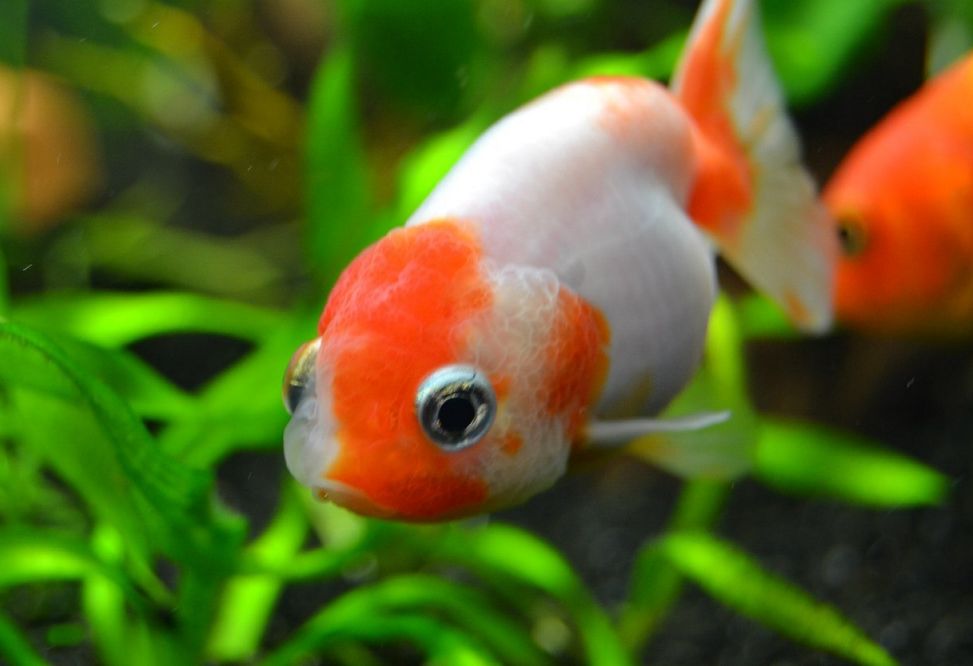
Tank decoration
When decorating the tank you should keep in mind one important issue: what kind of goldfish will live there. If you are planning to keep telescope, bubble eye, celestial eye you’ll have to forget not only about stones and bottom substrate particles with sharp edges, but also about tank plants with sharp edged leaves.
Otherwise, chances of hurting the fish are very high.
Avoid razor-edged stones and shells, snags with knots, since again the chances are high that the fish may hurt itself or tear one of its fins.
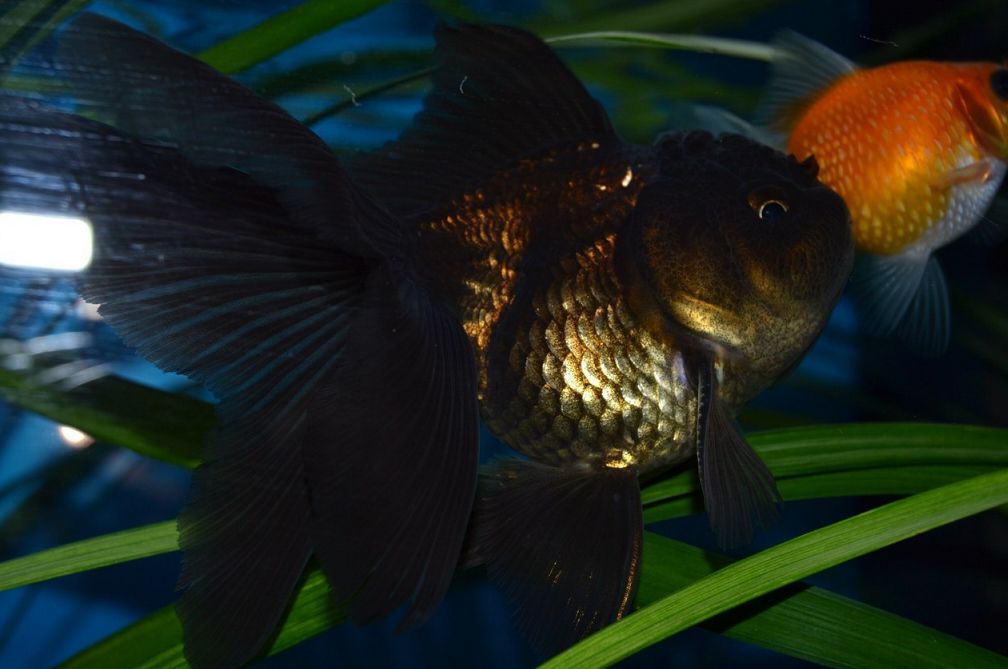
Aquarium plants and goldfishes
To put or not to put tank plants into a tank? Decidedly, put some plants there.
Having tank plants improves ecological environment in the tank, helps to deal with algae in it, looks nice and serves as a supplementary component to the fish diet.
However, there is a small issue in this respect. Fish eagerly eat almost any tank plants and can turn your ‘garden’ into a ‘desert’. Many aquarists think that in this case you shouldn’t bother and it’s better to forget about tank pants.
Though it is vise versa, this is exactly the reason why you should plant ‘tasty’ tank plants – they will make your pets diet diversified, serve as an additional source of vitamins and make the routine of the fish life brighter.
Besides, there is a large number of large or coarse leaved, or just not ‘tasty’ plants that the fish won’t be tempted to eat. Such plants will survive and act as additional stabilizers of ecological balance in the tank.
To make sure that the fish won’t dig out the plants each time when digging the bottom substrate, you can put some large rounded pebbles around the tank plant roots above the bottom substrate.
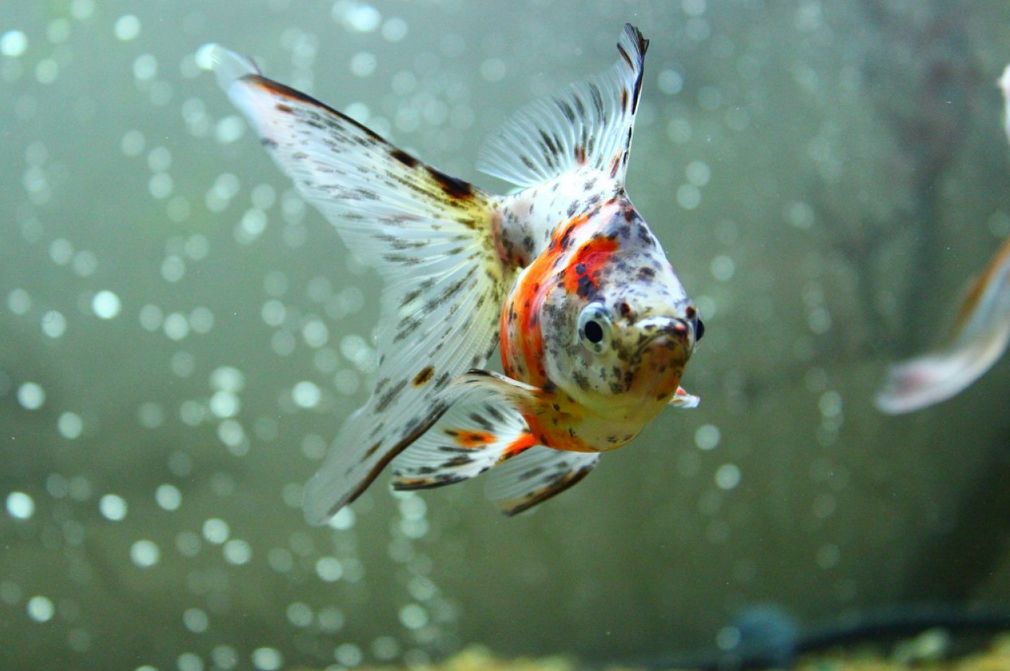
Bottom substrate
Tank bottom substrate graded 3-5 mm is proper for a tank, however you should consider that the fish like digging and at certain conditions a small stone may stuck in the fish mouth.
That’s why some aquarists recommend to put larger or smaller grained substrate. Though, you shouldn’t focus on this issue too much, since the above mentioned happens quite seldom; just make sure that the stones have no ragged or sharp edges.
If worst comes to worst, you’ll have to save the poor thing with the help of forceps or tooth picks.
Filtration
A distinctive feature of goldfish is that they produce too much organic waste both due to their physiology and their hobby of digging the tank bottom substrate.
That’s why a good internal filter for mechanical purification of the tank water is a must.
Such tank requires regular cleaning (washing out using the tank water during water renew). Also you should remember that filters have to work day-and-night.
Lifespan
How long do goldfish live? It is a complicated question, since it depends on the breed, tank conditions, care, tank mates and the fish diet. However, yet the fish lives quite long. Provided with good care and tank conditions lifespan is from 5 to 30 years. Yes, in large ponds at not high temperature some species (of course, the large ones) can live more than 30 years.
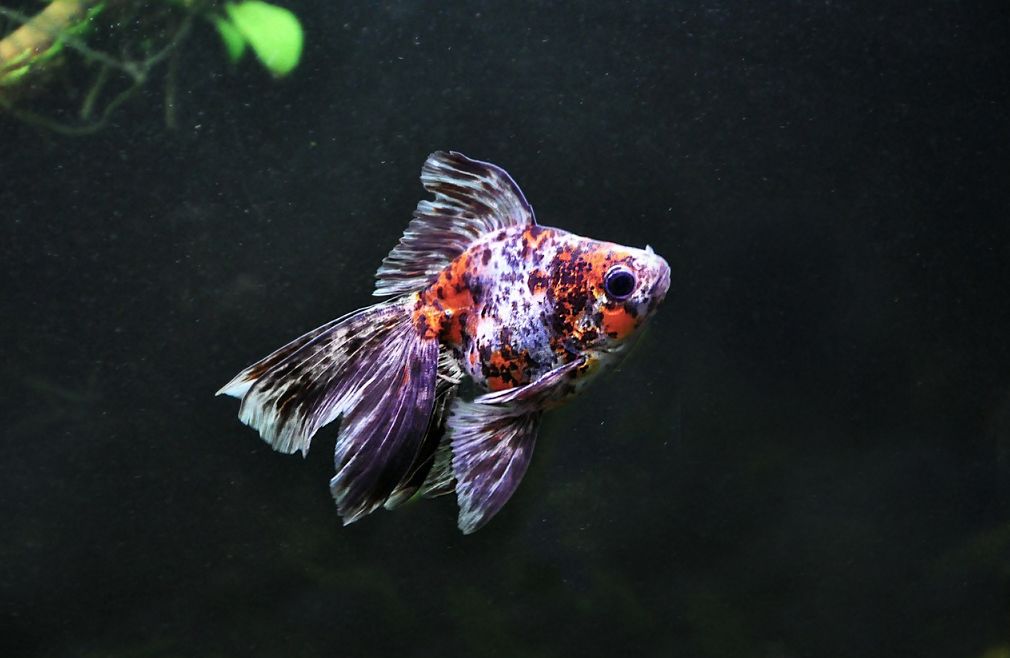
Feeding
Feeding is rather complicated issue for beginning aquarists in the first place. The thing is that the fish is quite gluttonous and it is always hungry. You see their unhappy faces every time you pass by the tank.
You have to feed goldfish with small food portions once or twice a day. Make sure that all the food is eaten in 5-10 minutes and give twice smaller portions (if you feed the fish twice a day).
Overfeeding is the most common problem when keeping these fish. It can easily lead to various diseases, first of all connected with gastrointestinal system.
Goldfish is omnivorous. Therefore, its diet should be diversified. Live food has to be included as well. Though, you should be careful with it, since quite often together with live food some infectious agents may get into the tank.
Frozen food is safer in this respect. Vegetable food and special food produced by several manufacturers can also be present in the fish diet.
Put dry food (such as flakes and special pellets) into a plate with the tank water for several minutes before giving them to the fish. Otherwise, there is a risk that food particles swollen after the fish eats them will cause gastrointestinal disturbance.
Frozen food should be frozen-thawed (till it is of a room temperature) before giving it to the fish and it has to be fed right after is gets frozen-thawed. When feeding juveniles with frozen brine shrimp, it is recommended to soak it in water to get rid of excessive salt content.
You can’t refreeze the food!
Various vegetable supplements have to be included into diet. These are lettuce, cucumber, cabbage, aneth, nettle etc. All of them should be put into boiling water, chopped and then given to the fish. Adult fish species can eat, for example, lettuce leaves without boiling or chopping them.
Some tank plans are also good vegetable food for the fish, such as – lemna, riccia, hornwort. Hornwort is double as useful, because this is a fast-growing plant and it intensively absorbs nitrogen from the tank water and this way it decreases nitrates concentration in the water.
A good way to make sure that you pets won’t starve when you are away and there is no one to feed them, is to put a bunch of hornweed into the tank. This will be enough for them for a long time.
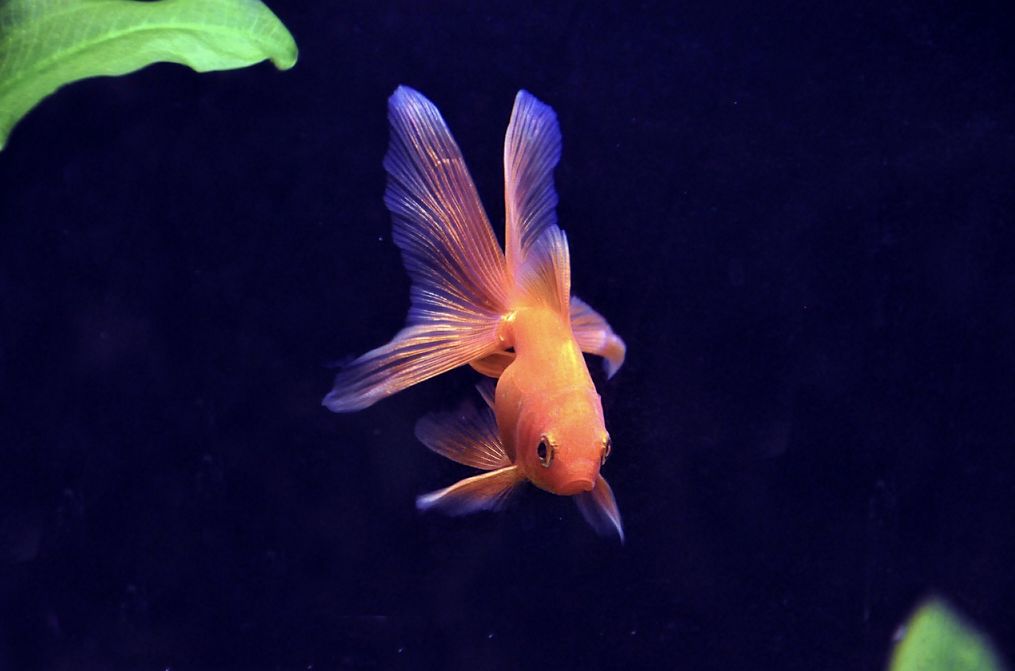
Compatibility and tank mates
Strange as it may appear, not all breeds are compatible with each other. There are fishes which are better to keep separately from others including their relatives. Besides, representatives of various breeds may differ in their temper, this is especially true about species with elongated and short bodies.
Fish species with elongated bodies is a special case. They are more active than those with short bodies, more often these are schooling species and they can grow very large up to 30 cm (20 inches) and even more (without including its tail fin length).
That’s why fishes with elongated bodies feel more comfortable in ponds. When keeping them in a tank, it has to be 200 liters large.
Due to the fish temper it is recommend to keep those with elongated bodies separately from short bodied ones. In general, these fishes (common goldfish, comet, subunkin) are quite undemanding, enduring and not very sensitive in terms of tank conditions change.
Among the short bodied fishes there are ones, that as we said above, you should better keep separately from others due to various reasons.
Telescope is very clumsy, weak-sighted that’s why its faster tank mates my leave it starving. Besides, its eyes are very vulnerable. The same is about celestial eye.
As for Bubble Eye, its tank mates may accidentally or in purpose injure their ‘bubbles’. Among these fishes group ryukin and fantail are considered to be the most undemanding. It is more difficult to keep oranda, celestial eye, ranchu, lionhead. Pearlscale and bubble eye definitely won’t do for beginning aquarists.
As for the most frequently asked questions: ‘Who can be a good tank mate?’, as a rule an absolute answer is – no one.
Goldfish are not compatible with any other tank fishes, the main issue is that all the fishes in a tank that won’t be eaten by goldfish, will start to eat goldfish anyway. There are real examples, when guppy almost ate live large clumsy goldfish (especially veiltail ones). Though, in their turn they can eagerly eat everything they can swallow.
Consider complicated ecological environment in the tank, their requirements to the water temperature and feeding schedule you will have to exclude almost all ornamental fishes from the list of tank mates.
Well, maybe only peaceful and undemanding catfishes can be an exception in this case and another good thing they do is cleaning the tank.
Though, here you also have to keep an eye on a situation, because it is not infrequent that even bristlenose pleco, which are typical plant feeders were feeding on goldfish with short bodies and they nipped their body sides to the bone.